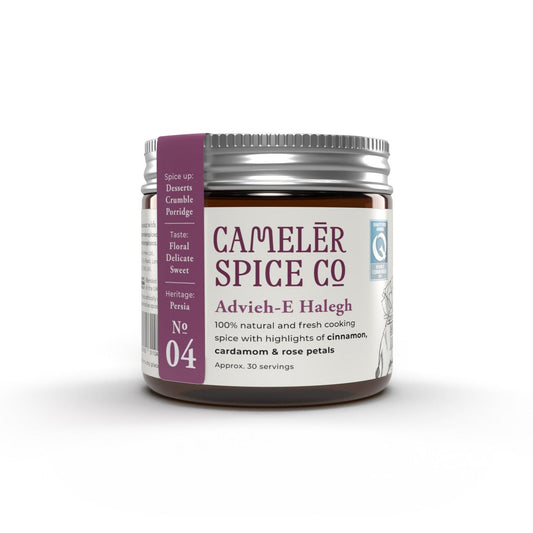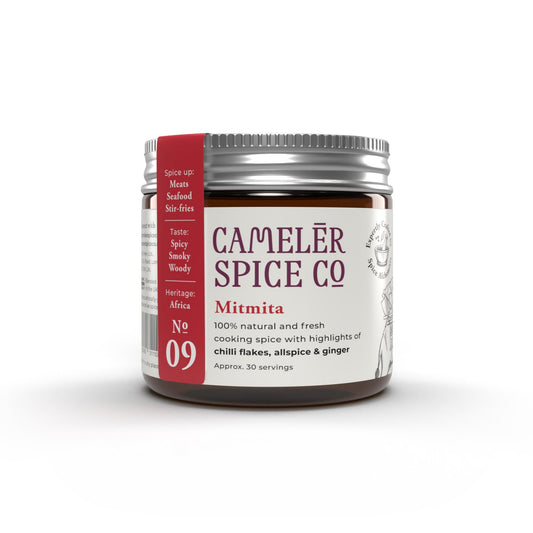
Collection: Ginger
(Also known as Ginger Root and Canton Ginger)
What does ginger taste like?
Fresh Ginger has a hot, woody and citrusy taste. Fresh ginger has the active compound gingerol. Ground dry ginger is used as an ingredient in gingerbread and ginger ale but it is also used to flavour curry and stir-fries. The Chinese have adopted ginger for thousands of years. The dry/ground version has more concentrated compounds and it does not have active gingerol. They both have different health benefits and taste very different.
What flavours go with ginger?
- Almond
- Apricot
- Aubergine
- Butternut Squash
- Cabbage
- Cardamom
- Chilli
- Cinnamon
- Clove
- Coffee
- Garlic
- Lemon
- Lime
- Mango
- Mellon
- Mint
- Onion
- Orange
- Rhubarb
- Tomato
- Vanilla
Our Ethiopian predominately savoury blend Mitmita a 3rd Century AD seasoning demonstrates the great harmony between ginger and chilli. Whereas our 6th Century BC Persian dessert Adveih-E Halegh blend is a marriage between ginger, cardamom, cinnamon and cloves, producing a sweet warming spice mix for baking. It goes without saying that ginger is the holy grail to the gingerbread man, where it is often anchored with a clove undertone. Advieh-E Halegh would certainly make an interesting biscuit and maybe a gingerbread man or house.
What's the difference between fresh and dry ginger?
Dried ginger tastes different from the fresh version, as it is stronger. This is why you should never replace fresh with dry. Middle Eastern demand for ginger has shifted from suppliers in Syria and Turkey to exports from India. You should try to avoid old ginger, as the flesh will be fibrous. It is from the same family as turmeric, and it is closely related to cardamom.
What are the health benefits of ginger?
Ginger has a long history of helping with nausea. It is also said to aid with digestion and saliva flow. It makes a great tea with lemon and honey.
What are interesting facts about ginger?
- The Arabs brought ginger to Europe during the 1300s. It was one of the earliest spices brought to ancient Greece and Rome. The Greeks would prescribe it for stomach complaints, and the Romans would use it for aromatic salts.
- Come the 9th Century, dried ginger was considered a tabletop condiment in Europe. By the Middle Ages, its use had evolved in savoury and sweet cooking, and beer and ale flavour enhancers.
- By the 16th Century, it had reached Jamaica, which is still considered a producer of high-quality ginger yield. The ginger plant is similar to that of bamboo. We eat the underground stem called "rhizome", but we do not eat the root.
- Gingerbread men originate from the English tradition of Elizabeth I, who gave them to guests assembled in their likeness. Gingerbread houses are a German tradition from the 19th Century.
- Ginger beer comes from the Victorian era.
- During the 13th and 14th Century, you could buy a sheep with a pound of ginger.
- The Japanese use ginger to cleanse the pallet, which is why you get pickled ginger with sushi.
What is the chief flavour compound in ginger?
Gingerol and zingiberene are just some of the flavour compounds. Gingerol: (hot, pungent and spicy) The pungent element of ginger will complement the capsaicin compound of chilli and the piperine warmth of black pepper. The zingiberene terpene compound carries ginger aromatics, but the taste compounds are a lot more complex, especially when dried.
Shop Spices With Ginger
-
Advieh-E Halegh
Regular price £8.95 GBPRegular priceUnit price / per




